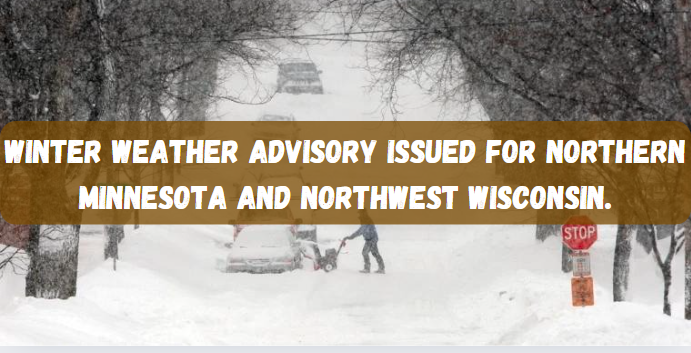As temperatures plummet and snow begins to blanket the landscape, a winter weather advisory has been issued for Northern Minnesota and Northwest Wisconsin. This advisory signals the onset of a cold spell characterized by frigid temperatures, heavy snowfall, and icy conditions.
In this comprehensive article, we delve into the specifics of the advisory, provide practical safety tips, and explore the broader implications of winter weather for residents of these regions. Our goal is to offer insights and analyses that go beyond the standard advisories and equip you with the knowledge to navigate the upcoming winter weather safely.
Understanding the Winter Weather Advisory
A winter weather advisory is an alert issued by meteorological authorities to inform the public about potential hazardous winter weather conditions. In this case, the advisory has been issued for Northern Minnesota and Northwest Wisconsin, two regions known for their harsh winter climates. The advisory indicates that these areas will experience conditions that may pose significant risks to safety and daily activities.
What to Expect
- Heavy Snowfall: Residents can expect substantial snowfall, which can lead to reduced visibility and hazardous driving conditions. Snow accumulation can vary, but it typically disrupts travel and daily routines.
- Icy Conditions: Freezing rain and sleet are likely, leading to the formation of ice on roads, sidewalks, and other surfaces. This increases the risk of slips, falls, and vehicle accidents.
- Frigid Temperatures: Temperatures are expected to drop significantly, leading to dangerously cold wind chills. Prolonged exposure to these conditions can result in frostbite and hypothermia.
Duration and Timing
The advisory specifies the expected start and end times of the winter weather event. It is crucial for residents to stay informed through local weather updates to know the exact timeline and prepare accordingly.
Preparing for the Winter Weather Advisory
Preparation is key to minimizing the impact of severe winter weather. Here are some essential steps to take:
Home Preparation
- Stock Up on Essentials: Ensure you have enough food, water, and medications to last several days. Non-perishable items are ideal.
- Insulate Your Home: Check windows and doors for drafts and insulate them to keep the cold out. Consider using weather stripping or caulking.
- Prepare for Power Outages: Have flashlights, batteries, and a backup heat source ready in case of power outages.
Vehicle Preparation
- Winterize Your Vehicle: Check your vehicle’s antifreeze levels, battery, brakes, and tires. Consider using snow tires for better traction.
- Emergency Kit: Keep an emergency kit in your car, including blankets, warm clothing, a shovel, ice scraper, and non-perishable snacks.
- Full Tank of Gas: Ensure your gas tank is full to avoid running out of fuel in case you get stranded.
Personal Safety
- Dress Appropriately: Wear layers of warm clothing, including hats, gloves, and scarves. Use thermal wear for added insulation.
- Limit Exposure: Avoid prolonged exposure to the cold, especially for young children, the elderly, and individuals with health conditions.
- Stay Informed: Monitor weather updates and heed any warnings or advice from local authorities.
Impact on Daily Life
Travel Disruptions
The winter weather advisory is likely to cause significant travel disruptions. Snow-covered and icy roads can make driving hazardous. Here are some tips to navigate travel during this period:
- Avoid Non-Essential Travel: If possible, avoid traveling during the advisory period. Stay off the roads to reduce the risk of accidents.
- Drive Slowly and Carefully: If you must travel, drive slowly and maintain a safe distance from other vehicles. Use low gears to navigate icy patches.
- Public Transport: Expect delays and cancellations in public transport services. Plan your journey accordingly and allow extra time for travel.
School and Work Closures
School and workplace closures are common during severe winter weather. Here’s how to stay prepared:
- Stay Updated: Check for announcements regarding closures from local news sources or official channels.
- Remote Work and Learning: If possible, arrange for remote work or online learning to minimize disruption to your schedule.
- Childcare Plans: Have a contingency plan for childcare in case schools close unexpectedly.
Broader Implications of Winter Weather
Economic Impact
Severe winter weather can have significant economic implications. Businesses may experience disruptions in operations, leading to financial losses. Here’s how different sectors are affected:
- Retail: Reduced foot traffic due to hazardous conditions can lead to lower sales.
- Transportation: Delays and cancellations in transport services can affect logistics and supply chains.
- Healthcare: Increased demand for medical services due to weather-related injuries and illnesses can strain healthcare facilities.
Environmental Impact
Winter weather events also have environmental implications. Heavy snowfall can benefit water reservoirs, but it can also lead to flooding when the snow melts. Additionally, the use of de-icing chemicals can have adverse effects on local ecosystems.
Social Impact
The social impact of winter weather includes both challenges and opportunities for community building:
- Isolation: Prolonged severe weather can lead to social isolation, especially for vulnerable populations. Community support is crucial.
- Community Efforts: Winter weather often brings communities together. Neighbors helping each other with snow removal and other tasks can strengthen community bonds.
Insights and Analyses
The Role of Climate Change
Climate change has been linked to increasingly unpredictable and severe winter weather patterns. While global warming suggests higher average temperatures, it also contributes to extreme weather events. Understanding this connection can help in planning and mitigation efforts.
Technological Advancements
Advancements in technology have improved weather forecasting and communication. Real-time updates and sophisticated modeling tools allow for more accurate and timely advisories. Embracing these technologies can enhance preparedness and response.
Psychological Impact
The psychological impact of severe winter weather should not be underestimated. The stress and anxiety associated with disruptions and safety concerns can affect mental health. It is important to address these issues and provide support.
Frequently Asked Questions (FAQs)
1. What is a winter weather advisory?
A winter weather advisory is an alert issued by meteorological authorities to inform the public about potential hazardous winter weather conditions, including snow, ice, and frigid temperatures.
2. How should I prepare my home for a winter weather advisory?
To prepare your home, stock up on essentials, insulate your home, and prepare for power outages by having flashlights, batteries, and a backup heat source ready.
3. What should I include in my vehicle’s emergency kit?
Your vehicle’s emergency kit should include blankets, warm clothing, a shovel, ice scraper, non-perishable snacks, and a first aid kit.
4. How can I stay safe while traveling during a winter weather advisory?
To stay safe, avoid non-essential travel, drive slowly and carefully, and stay updated on weather and road conditions. Use public transport cautiously and allow extra time for delays.
5. How does severe winter weather impact the economy?
Severe winter weather can disrupt business operations, affect transportation and logistics, reduce retail sales, and strain healthcare services due to increased demand.
6. What are the environmental impacts of heavy snowfall?
Heavy snowfall can benefit water reservoirs but may lead to flooding when it melts. The use of de-icing chemicals can negatively affect local ecosystems.
7. How does winter weather affect mental health?
The stress and anxiety associated with severe winter weather and disruptions can impact mental health. Community support and mental health resources are important during such times.
8. What is the connection between climate change and severe winter weather?
Climate change contributes to increasingly unpredictable and severe winter weather patterns, leading to more frequent and intense extreme weather events.
9. How have technological advancements improved winter weather preparedness?
Technological advancements have improved weather forecasting and communication, allowing for more accurate and timely advisories, which enhance preparedness and response.
10. What can communities do to support each other during severe winter weather?
Communities can support each other by helping with snow removal, checking on vulnerable neighbors, and providing mutual aid and resources during severe weather events.
Conclusion
The winter weather advisory issued for Northern Minnesota and Northwest Wisconsin underscores the need for preparation and vigilance. By understanding the specifics of the advisory, taking proactive measures, and staying informed, residents can navigate the challenges posed by severe winter weather.
Beyond the immediate impact, it is essential to consider the broader implications for the economy, environment, and community. As we face increasingly unpredictable weather patterns, preparedness and community resilience remain key to ensuring safety and well-being.





















+ There are no comments
Add yours